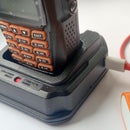Introduction: Baofeng: Improve, Upgrade, Repair the Charger for Baofeng Radio
Baofeng makes great radios: a legendary UV-5R, improved UV-S9, UV-82, waterproof UV-9R, etc., still equips them by junk chargers☹ that frequently overheat, fail and burn out. Looks like the primary task of the stock charger is to generate heat, charging is secondary...
I am glad to share my experience on replacing inner electronics of Baofeng Charger with TP5100 charging module. That would significantly improve the Charger:
- TP5100 is a switching charging chip; so, it’s more efficient, reliable, generates less heat than the analog stock chip.
- TP 5100 extends the range of input voltages from the stock 10v to up to 18V. So, you may connect the charger to +12...14V car outlet or to any other DC voltage source in the range.
- TP5100 has multiple protections (see below) that would ensure secure and safe charging as well as a long life of your Baofeng battery.
Supplies
About TP5100 Chip
TP5100 is a small intelligent beast - a step-down (switching frequency of 400kHz) 8.4V double/4.2V single lithium battery charge management chip specially designed for portable devices. TP5100 is equipped by built-in:
- input over-current and under-voltage protection,
- over temperature protection,
- short circuit protection,
- battery temperature monitoring (optional, not used here),
- reverse battery protection,
- short-circuit protection.
TP5100 has 5V-18V wide input voltage range, the battery trickle charging into pre-charge, constant current, constant-voltage three phase. TP5100 with a frequency of 400kHz switching mode makes it possible to charge at up to 2A current still maintain a smaller amount of heat.
Links to buy the TP5100 module:
Step 1: Configure TP5100 Charging Module
TP5100 charging module is configured to 4.2v and 2A by default. While we need 8.2V and 0.5A for Baofeng’s battery.
- Set 8.4v charging voltage: short-circuited the SET pads (refer to pictures)
- Set the charging current: 500mA charging current may be configured by using the stock resistors: unsolder both R100 resistors and solder them in sequence like a top-roof as shown at the picture. That would make the value of 0.2 Ohm setting the desired 500 mA current.
If your Baofeng radio is equipped by a larger battery like 1800 mAh and higher, then unsoldering just one 0.1 Ohm resistor would set the charging current of 1A. That would be good for large batteries and provide twice as fast charging comparing to 500mA charging current.
Please, be alert: sellers at eBay, AliExpress and other tend to overstate significantly the capacity of Baofeng batteries, market them as 4800mAh, 8000mAh, and even more. Do not let them fool you. The real capacity of Baofeng batteries is usually 1400mAh-1800mAh and does not exceed 2200mAh, maximum 2400mAh for new Baofeng radio models like UV-82. No one can trick the physics of Li-Ion batteries; it's impossible to squize a larger battery into the size-limited case.
For your reference: the formula to define the value of the current setting resistor Rs in Ohms by a desired charging current Icharge in Ampers:
Rs = 0.1/Icharge.
So, for 500mA charging current Rs = 0.1V/0.5A = 0.2 Ohm
Step 2: Open the Charger
Use an old credit card to open the bottom cover of the charger case. There are two plastic locks at the back side about ½ inch on both sides of the charging connector. Be gentle, do not brake them out...
Step 3: Disable the Stock Charger Chip
We re-use the sock board because it holds the charging connector in place. So:
- Cut the positive trace as show at the picture to disable the stock charging chip.
- Unscrew the stock board and remove/cut/un-solder the LED-charging indicator.
Step 4: Wire the TP5100 Module
Wire the TP5100 module as it’s shown at the picture:
- Two Black ground wires from the input connector: #1 goes to the negative charger battery pin, #2 -> to the module negative output (or input, both negatives input and output are short-connected on the module).
- Red wire #3 from the input connector –> to the module positive input.
- Red wire #4 from the module positive output -> to the battery positive charging pin.
Step 5: Mount the TP5100 Module
- Add a drop of hot glue to the whole from inside the charger where the stock LED used to be to form a kind of lens for the module LEDs to be a visible.
- Position charging module in a way that onboard LEDs are close to the lens (you can see the module is shifted a bit to the right). Fix the module by hot glue. I’ve also added a double-sided adhesive tape between the module and the stock board to fix it firm.
- Screw the stock board back into its place.
- Close the charger bottom cover by closing it at the front first and then by locking the rear locks and we are done!
Enjoy the improved Charger for your lovely Baofeng radio!
Step 6: Example of UV-9R Plus Charger Repair
Another example of a modern UV-9R Plus charger repair...
De-soldered all the elements on the charger board except capacitors and two-color LED. Connected LED to the TP5100 module. Works like a charm :-)






